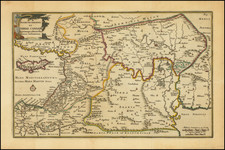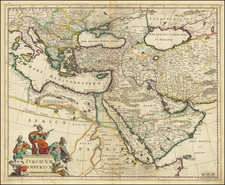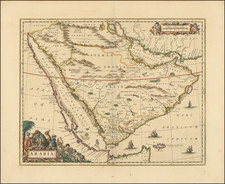Arabia, a large format map of the Arabian Peninsula, the Persian Gulf, the Red Sea and surrounding areas, was issued by John Pinkerton in London in 1813. The map offers a rich topographical vista of the region, with a particular focus on the vast expanses of the Great Desert and the Province of Neged.
The map's dominant feature, the Great Desert, is balanced by the intricate detailing of mountains, rivers, and other natural elements throughout the peninsula. This fusion of the grand scale and excellent detail paints a comprehensive picture of the region, reflecting Pinkerton's dedication to creating an accurate and informative cartographic resource.
The map notes a number of key locations in what is now the United Arab Emirates and adjacent areas, providing valuable historical context for the development of the region. For instance, it identifies Kattar, present-day Qatar, along with other notable places, reflecting the geopolitical landscape of the time. Of particular interest, Sharjah is marked as Sharedsje Island, located at the mouth of the Flag River, indicating how place names have evolved over time.
John Pinkerton's elephant folio atlas, from which this map originates, is celebrated as one of the finest engraved works of its era. Though not as widely recognized as the atlases produced by contemporaries like Cary and Thomson, Pinkerton's work stands out for its superior detailing and commitment to accuracy. This map of Arabia exemplifies the high standards of his work, making it a remarkable asset for scholars of regional geography and history.
John Pinkerton (1758-1826) was Scottish literary critic, historian, poet, and geographer. From age twelve he educated himself at home in Edinburgh, as his father had declined to send him to university. His father instead apprenticed John to a lawyer, William Aytoun, but the boy did not like the legal profession. In his spare time, the young man wrote poetry and collected Scottish ballads, which he tried to have published. After the death of his father, Pinkerton moved to London in 1781, to be closer to the vibrant literary scene.
Pinkerton’s earliest publications were collections of ballads. However, a fellow critic uncovered that Pinkerton had forged several of the “ancient” poems and published accusations against Pinkerton in the Gentleman’s Magazine. Throughout the 1780s, Pinkerton published poetry, works on numismatics, and historical works. He corresponded with Sir Walter Scott, Horace Walpole, and Edward Gibbon, but most of his friendships ended in acrimony. Pinkerton was a hypochondriac, unorthodox about morality and religion, and a prickly personality who lived with several women during his lifetime, marrying illegally at least once.
After 1800, Pinkerton turned to geographical works. In 1802 he published Modern Geography, a text that was quite popular and translated into French and Italian. In 1808-15, he produced a New Modern Atlas, which was well received, followed by A General Collection of Voyages and Travels (1808-14). Soon after these projects, Pinkerton moved to Paris, where he lived until he died in 1826.










![[ Paradise ] De Gelegentheyt van t'Paradys ende t'Landt Canaan, Mitsgaders de Eerst Bewoonde Landen Der Patriarchen uyt de H. Schrifture en verscheyden Auctoren by een gestelt door Nicolaes Visscher](https://storage.googleapis.com/raremaps/img/small/85711.jpg)

![[Pictorial Map of the United Arab Republic] Kharitat Musawwarat al-Jumhuriya al-'Arabiya al-Muttahida / خريطة مصورة الجمهورية العربية المتحدة](https://storage.googleapis.com/raremaps/img/small/55146.jpg)

![[ Black & Caspian Sea Region ]. Tabula Asiae III [](https://storage.googleapis.com/raremaps/img/small/76322.jpg)